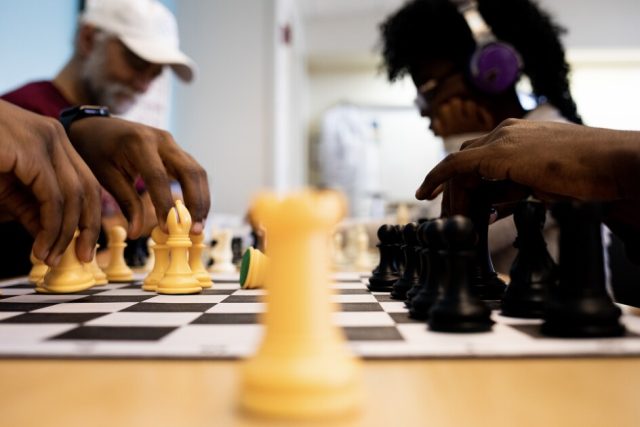[ad_1]
It’s been almost a month since 13 high school students and their coaches from Renaissance High School, a public magnet school in Detroit, Mich., piled on a bus for the nine-hour ride to Washington, D.C.—the first visit to the nation’s capital for most—to compete in a three-day national high school chess championship.
They’re still riding high.
The small but dedicated group of students beat more than 400 students and 67 teams to win the U.S. Chess Federation National High School Championship in their category. The winning players were selected from among the school’s 20-some-member chess team to attend the national tournament. It was a first for the school of approximately 1,175 students, of which 99 percent are Black, 1 percent is Hispanic, and 54 percent qualify for free or reduced lunch, according to state and federal data on the school.
The win brought both national and peer recognition to the small chess team, whose members were accustomed to playing in relative obscurity before becoming national champions.
“Since we won the national championships, everybody at school wants to play,” said Corey Boyce, a sophomore at Renaissance who helped lead his team to victory at the championship.
The game’s surge in popularity
The spike in students’ interest in chess at Renaissance comes as the ancient game is surging in popularity among all ages, including children and teens. Online play is up 238 percent since 2020 at Chess.com. This January, the website recorded an all-time number of active users (over 10 million), causing it to crash.
The pandemic-related shutdowns of schools, workplaces, and gathering places created the perfect opportunity for a surge in online chess play. But attendance at this spring’s national high school champions was also record-setting, signaling how much the game has resonated with young people. The tournament, which normally hosts between 1,300 and 1,400 players, welcomed more than 1,750 this year, according to the U.S. Chess Federation, which ran out of medals for participants.
The uptick in chess play has not been lost on teachers. One Reddit post from a high school teacher discussing her “chess-obsessed” male students garnered hundreds of comments. And while some teachers report being frustrated by the distraction it’s presenting—think students surreptitiously huddled over cellphones or laptops as they play online during class—others tout the game’s positive impact on academic and life skills.

How chess benefits students
Robert Taliaferro, an inductee of the Detroit City Chess Club’s Harold Steen Hall of Fame, has coached the Renaissance chess team for the past seven years. He said the game has been a win-win for his players. “First of all, it keeps them safe and off the streets,” Taliaferro said. “Not only are they safe, but they’re learning things that could help them in life.”
Taliaferro disagrees with the stereotype of chess being a game for “smart” kids.
“Some people say, ‘Well, they’re smart kids and that’s why they play chess.’ I believe chess broadens their intellect,” he said. “How much you put into it is how much you get out of it.”
Opemipo Clement would probably agree. The senior at Renaissance and co-captain of the chess team, who learned to play at the age of 7 in his native Nigeria, is heading to Brown University next year. He talks about the commitment he brings to the chess board.
“We’re always playing, always getting better,” he said. “We’re trying to build our repertoire of skills.”
The senior admits that his intense practicing partly stems from a competitive mindset. “We’re trying to bring our best foot forward to the tournament,” Opemipo said.
Corey, his teammate, describes the intensity of tournaments. “You have to think for hours, try to think your way out [of a given situation on the board],” he said.
Studying the impact
While some educators see chess playing as a potential distraction in the classroom, others have brought it to the school intentionally. Several countries—including the United Kingdom, Spain, Turkey, Germany, Italy, Venezuela, Armenia, and Hungary—have introduced chess into the school curriculum, according to George Chitiyo, a professor of curriculum and instruction at Tennessee Tech University, who has studied the benefits of chess for schoolchildren.
His study involved 62 teachers of grades 2 through 8, who participated in a five-year program. Teachers attended a four-day professional development workshop prior to the start of the school year that taught them how to play chess and how to use the game in the classroom to teach skills such as critical thinking. They also were required to include chess or chess-based lessons at least one hour during the school day, and to establish after-school chess clubs.
In a survey, high percentages of participating teachers said they noticed that students who played chess in class improved in:
- problem solving (78 percent)
- strategic thinking (75 percent)
- critical thinking (73 percent)
- decision making (64 percent), and
- interest in school (62 percent).
The most persuasive evidence of the game’s benefits may come from student players themselves.
“I might not be the best, but I enjoy the learning process and the game in general,” said Opemipo, the Renaissance team’s co-captain. “It’s about studying, playing, just really tasking your brain to find these winning ideas in these difficult positions.”
[ad_2]
Source link











